A Broken Penis
is
A Medical Emergency
"A broken penis (also called penile fracture or corporal rupture) is considered an urgent medical condition that requires prompt repair to prevent long-term complications. Complications can include of penile curvature, chronic pain, and erectile dysfunction."
ref: Dr. Ian S. Metzler, et al
Suspected penile fracture: to operate or not to operate?
https://www.ncbi.nlm.nih.gov/pmc/articles/PMC5673800/
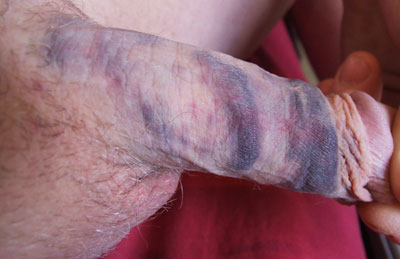
A broken penis (fractured penis, corporal rupture) will look like someone beat your dick up. Black and blue. Maybe purple and red. Possibly swollen. Probably painful to touch.
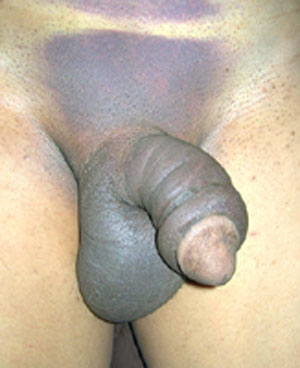
And, when it first happens, it’s not something that will go unnoticed. It hurts! A lot.
When a penis breaks, it is a serious medical emergency. You must get to a medical emergency room immediately. If indeed you did break your penis, a prompt surgical repair is typically recommended.

What happens if you just wait?
Well, maybe nothing. OR: Your penis may start to decay inside and it will be amputated to avoid your death.
I know. That’s really dramatic. It’s not common. But, it is true and it happen.
“Can I Break My Penis
When It Is Flaccid (soft)?”
That’s a good question.
Probably not. Even if you are quite rough with it.
A broken penis will usually only occur when a man's penis is erect. A flaccid penis does not typically fracture because the corpus cavernosa and tunica albuginea are very soft and flexible. It’s more able to bend and withstand unexpected forces.
It’s actually extremely difficult to break a flaccid penis. Another one of Mother Nature’s genius safeguards.
Broken Penis
Symptoms
There are a number of symptoms you should be aware of if you suspect you have a broken penis:
- An audible snapping or popping sound during rough sexual activity
- A sharp pain
- Followed by a sudden loss of your erection
- Continued pain that varies from minimal to severe following the injury
- Dark bruising above and/or around the injured area
- A bent penis
- Blood leaking from the tip of the penis
- Rarer symptoms of a broken penis include swelling and/or discoloration in the scrotum and blood in the urine
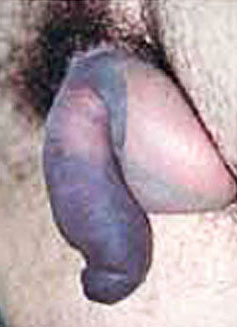
If you feel a sharp pain in your shaft while you are erect and having sex, hear a snap, you lose your erection suddenly, then the shaft (and possibly surrounding areas) starts turning colors, please, drop what you are doing, and get yourself to a medical emergency room as soon as possible.
If it is not that painful, your erection remains, and you are able to continue having sex comfortably, but bruising appears later, get it checked as soon as possible.
Repair results are best, with least side effects later, if they are performed within 24 hours of the injury.
What Broke?
Right? I mean you already know there are no bones in your boner. So what broke? And, why is it bleeding in there?
Here’s what happened:
Inside your shaft there are 3 erectile chambers, and, a thin strong sack that surrounds them.
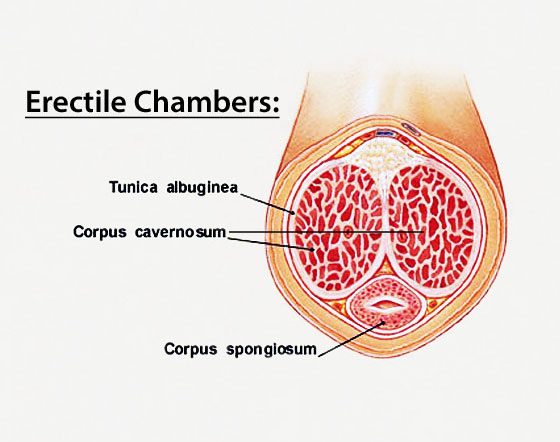
The 3 chambers are:
- The corpus cavernosum (2 chambers)
- The corpus spongiosum (1 chamber)
The sack that surrounds them:
- The tunica albuginea (sometimes called the penile sheath)
The Corpus Cavernosum are the main erectile chambers. They are responsible for your erection.
The Corpus Spongiosum is a small chamber that protects the urethra from compression during erection so that the semen can flow out easily during ejaculation.
The Tunica Albuginea is the thin strong sack, like a balloon, that becomes filled up when the corpus cavernosum fill with blood. When it is stretched to it’s limit, your erection gets hard. This is what makes it feel like there is actually a bone in there. Even though there is not.
When any of these part tear, you have a broken penis.
Can a Broken Penis Be Avoided?

Usually.
Here are five safety tips that can prevent a broken penis:
1) Make sure your partner is sufficiently wet, or lubricated, before penetration.
2) Be very careful of “hard penetration”.
3) Avoid trying to force an erection into tight underwear or clothing. Let the erection fade first.
4) Avoid rolling over on an erection while in bed.
5) Any sudden bending force on an erection can cause serious injury. Erections were never designed to be bent at all. Not even a little bit.
Sex Positions
Some sex positions are much more dangerous and much more likely to cause a broken penis.
Your erection was designed to go straight in and out of a vagina. Nothing else. The angle of your erection and the angle inside the vagina match in missionary position.
However, most couples have at least one or two other things they like doing. Right?
Playing around in different sexual positions can be fun, heighten sexual arousal and response, and can improve sex life.
You just have to be careful.
Dangerous
Sex Positions
So what positions are more dangerous?
Any time the woman is on top the shaft will be pulled abnormally. If you’re careful, no problem.
Also, when a woman is on top, she usually controls the movement. When she gets excited, her entire body weight can land on the erection. And, the man can’t stop her.
Also, the rougher you get, the more risk you take. Especially with dangerous positions.
Here’s what to look out for:
Any position that pulls the erection downward is going to be a risk. The greater the pull, the more the risk.
Positions like “Reverse Cowgirl” and “Snow Angel” are especially dangerous.


What About
Penis Surgery?
The severity of the surgery will depend on the extent of the internal damage.
Surgery may be done with a simple incision of about an inch, or, by the older method that uses degloving. A truly horrible experience that may leave you impotent. You want to avoid degloving if at all possible.
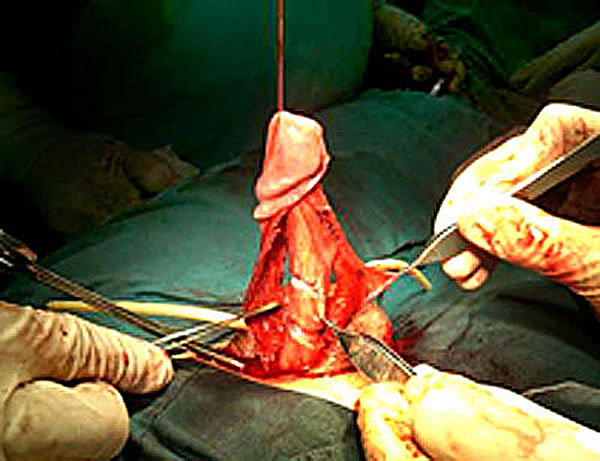 degloved penis
degloved penisDegloving means, “peeling off the entire skin on the shaft”. It may be used because the internal tissues are very swollen and the exact location of the tear can not be felt by the surgeon.
The surgery is a nightmare. It involves general anaesthesia, a 3-5 day hospital stay, a drain in your penis to let out the fluids that form from the surgery, and, probably a catheter for one or two weeks.
After that, you may be left impotent from nerve damage.
The other procedure is done with a simple one inch incision over the torn area.
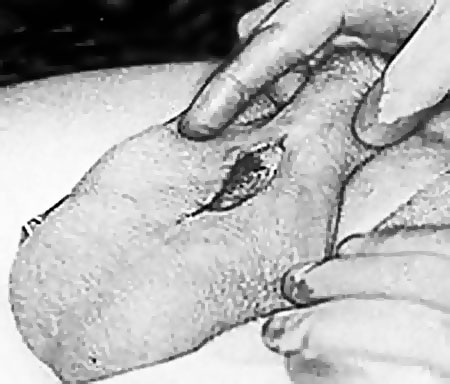 minimally invasive broken penis surgery
minimally invasive broken penis surgeryThis procedure takes only about 15 minutes. Normally it is an outpatient procedure (you’ll go home the same day). And, normally, it heals without complications.
Can You Choose
The Type of Surgery?
Possibly.
If the tear is severe and immediate surgery is necessary, you may be stuck with degloving if the doctor is not sure of the exact location of the tearing and has no access to ultrasound imaging. The tear can sometimes not be felt because the swelling is severe. Degloving makes it visibl e.
However, the use of penile ultra sound can easily identify a tear.
“....Physical exam frequently cannot differentiate a penile fracture (broken penis) from a superficial penile hematoma (a solid swelling of clotted blood) or penile ecchymosis (bruise). Penile US (ultrasound) allows for clear imaging of the tunica and corpora cavernosa of the penis and can easily detect tunical disruption (tearing)....”
ref: Translational Andrology and Urology, October 2016
Suspected penile fracture: to operate or not to operate?
https://www.ncbi.nlm.nih.gov/pmc/articles/PMC5673800/
With ultrasound, degloving should rarely be necessary. In any event, it is wise to discuss the situation with your surgeon first.
Immediate action may not be necessary. Even without access to ultrasound.
After 7-12 days, most of the swelling will be gone. Then, the break or tear can usually be felt very easily (a small hard lump) by hand. The surgeon knows exactly where to operate.
Explain to your surgeon that you know both of the surgical techniques and that you’d prefer the minimally invasive one if possible.
Degloving is only sometimes necessary immediately if the internal bleeding is so severe that it is life threatening, or, if your penis is at risk of gangrene (decay).
If your doctor says you can wait 7-12 days for surgery, you will most likely be able to choose the simple outpatient procedure. Most of the time this is possible.
In these cases the broken penis needs only to be cut open about one inch and the surgery performed.
In any event, prompt treatment of a broken penis is vital to ensure a man can return to his full sexual and urinary function.
After
Your Broken Penis Heals
Unfortunately, your nightmare may not be quite over.
Any time you tear a soft tissue, it will heal up with a scar. This is normally a very good thing. It’s always necessary.
But, a scar on the tunica albuginea or the erectile chambers may harden quickly or in time and cause Peyronies disease. A bent penis.
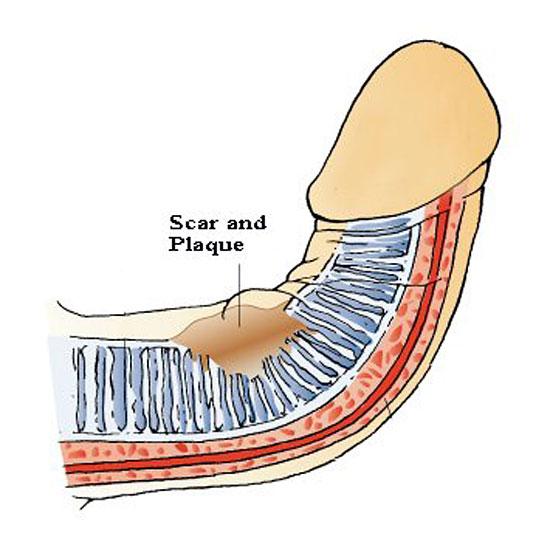
Peyronies is not really a disease, but, it is an unpleasant condition that can develop from scarring and it will require it’s own treatment when it interferes with sexual intercourse.
If your surgery was complicated, you may also experience impotence, lack of sensation, inability to orgasm,....
“Reported long-term complaints after penile fracture repair include penile deviation (curvature), painful intercourse, painful erection, erectile dysfunction, priapism (prolonged uncontrollable erection), skin necrosis (death), arteriovenous fistula (an abnormal connection or passageway between an artery and a vein), urethro-cavernous fistula (abnormal urethral connections), and urethral stricture (narrowing of the urethra, the tube your semen and pee comes out through).”
“Penile curvature remains the most common long-term complaint.”
ref: Dr. Gregory S. Jack MD, Dr. Isla Garraway MD, PhD, Richard Reznichek MD, Jacob Rajfer MD
Current Treatment Options for Penile Fractures
https://www.ncbi.nlm.nih.gov/pmc/articles/PMC1472832/
Fortunately these things are not common with the small incision procedure. Less than 4% of cases. With degloving, due to the large amount of scarring, you have a 25% chance of penile bending as time goes on.
CONCLUSIONS

The most important thing to remember is this: A broken penis is a medical emergency. If you even suspect that you have just gotten one, get to a medical emergency room immediately.
Degloving is no longer necessary to determine where the tear is. Ultrasound imaging can find the tear clearly. This enables the use of minimally invasive surgery.
Minimally invasive surgery for a broken penis results in much quicker recovery time and less post-op complications.
Be Well.....
~ William

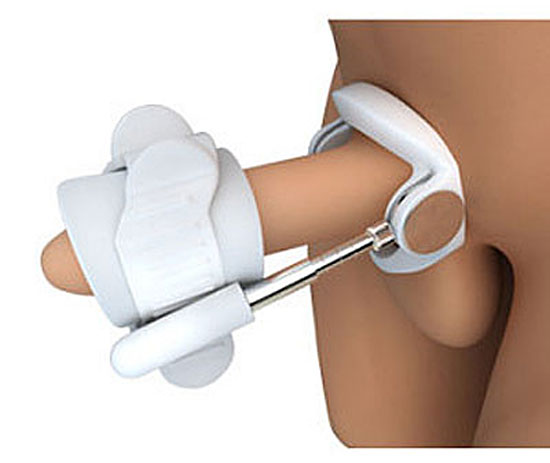




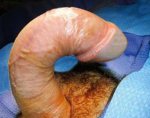

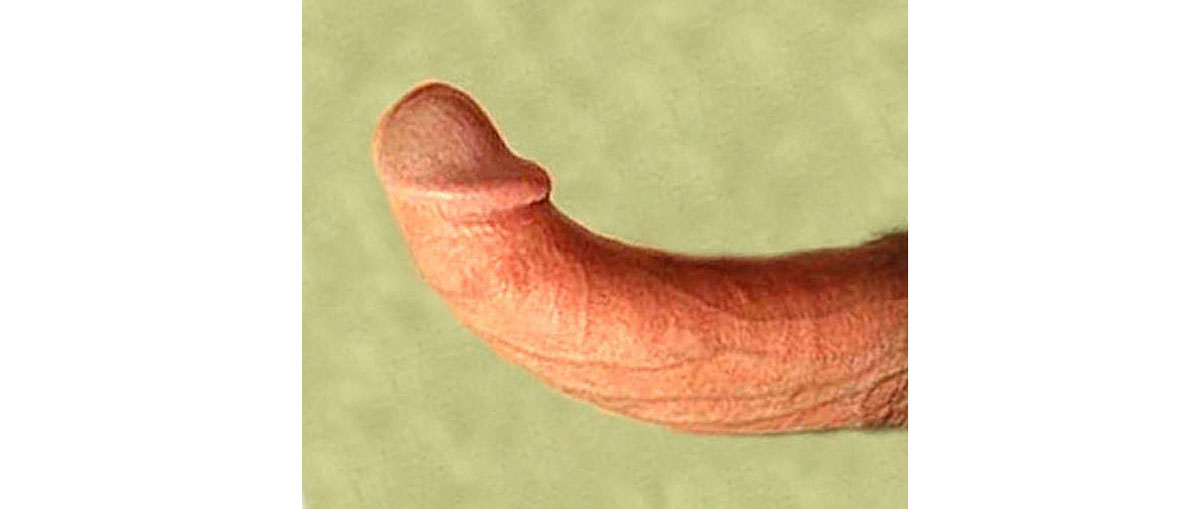



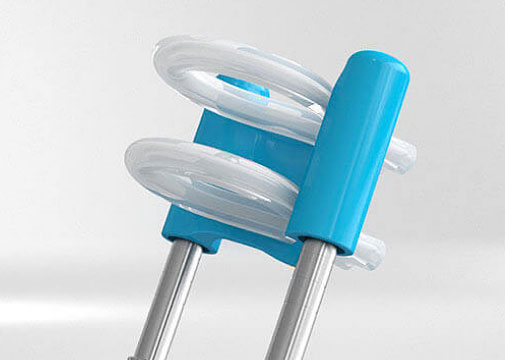

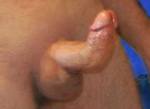


New! Comments
The Bent Penis Org authors and I would love to hear what you have to say about the pages you have read here. Your thoughts are important to us. If you can, please leave us a comment in the box below. Thanks! ~ William